
Walterclough Hall, sometimes known as Water Clough Hall or Upper Walterclough, lies in the Walterclough Valley south-east of Halifax and north-east of the village of Southowram in the West Riding of Yorkshire, alongside the Red Beck. [1]

Walterclough Hall, sometimes known as Water Clough Hall or Upper Walterclough, lies in the Walterclough Valley south-east of Halifax and north-east of the village of Southowram in the West Riding of Yorkshire, alongside the Red Beck. [1]
The Hall was originally built by the Hemingway family, first recorded there in 1379 [2] and in residence until 1654. [3]
In that year Walterclough Hall was bought by William Walker (1596–1676), before he moved to Lower Crows Nest. The initials of his second son, Abraham Walker (1629–1695), and of his wife Anne née Langley (1643–1688), were inscribed on the building. They were non-conformists and subject to the restrictions and harassments of the day. Their second son, Richard Walker (1672–1721), inherited the Hall from his father, and when he drowned in a canal, his son John Walker inherited the Hall from him.[ citation needed ]
John Walker (1699–1771) was the squire of Walterclough Hall in the mid-18th century and a woollen factor of great prestige and wealth. While he and his wife, Ruth née Nodder, had four children—Richard (b. 1731), John (b. 1735), Grace (b. 1738) and Mary (b. 1740)—they also adopted his nephew, Jack Sharp, and provided a home for four aunts and two uncles.[ citation needed ]

John Walker’s youngest son, John, took no part in the business, so when his eldest son Richard died and John senior retired and left the district, Jack Sharp was left in possession of the business and the Hall, which he consumed with calculated avarice. In 1771, when John senior died, his surviving son John junior gave his cousin notice to quit the Hall. When he arrived from York with his new wife, he found the estate had been excessively mortgaged and most of the contents of the Hall had been removed. Only two rooms remained furnished, and what was left behind had been trashed. In 1778, Jack Sharp built Law House from the proceeds of his villainy on nearby Law Hill.[ citation needed ] Later, Miss Patchett established a Ladies Academy at Law House, and Emily Brontë taught there for six months in 1837-38. Her experiences at Law House and the now almost legendary story is believed to be the source for her only novel, Wuthering Heights . [4]
In April 1867, the estate of the other Walker family of Crows Nest was sold by auction. This included most of the land at Hipperholme, Lightcliffe and Bailiff Bridge, as well as Crow’s Nest Mansion and Cliffe Hill Mansion.[ citation needed ] What happened to Walterclough Hall at this time is not yet known.
However, by 1870, Walterclough Hall had become a young ladies boarding academy. Elizabeth Ann Gregory ran the academy with her sister, Emma, and their sickly live-in brother, Charles.[ citation needed ] She employed four staff members. In 1871, there were two governesses, a cook, and a housemaid, and, in 1881, a governess, a cook, a kitchen maid, and a housemaid. She may also have employed four children, paying them with an education, free board, and lodging. [5] [6]
For the 1871 census, 18 young ladies were in residence, aged 11 to 19, and almost all from more distant parts; they were: Jessie Mosley, Fannie Mitchell, Helen Walter, Helen I. Simpson, Catherine Brown, Annie S. Aspinwall, Eleanor S. Graves, Mary I. Marsden, Marian Lomas, Sarah I. Speak, Clara Slack, Alberta Hellowell, Margaret Dempster, Gertrude Glendinning, Annie Bancroft, Elizabeth Wrigley, Amy Percival, and Mary D. Hamilton. There were also four young children, Francis Churchyard, Mary A. Stocks, William Town, and Arthur Town. [5]
For the 1881 census, 14 young ladies were in residence, aged 14 to 17, but mainly aged 15 and 16, and over half from the surrounding region: Julia Bancroft, Anne M Kirby, Fanney[ sic ] Longworth, Kate White, Mary A. Whitiker[ sic ], Faney[ sic ] M. Scarby, Kate M. Smeeton, Ada Thomas, Lucy Lumb, Mary Blenkhorn, Florence Hirst, Annie Whitaker, Mary A. Bleasdale, [7] and Susan Bentley. There were also four young local children: Rhoda Hoyle, Ethel Greenwood, Charles P. Greenwood, and Joe Walsh. [6]
However, the changing demographics of the academy suggest the school’s reputation was in decline along with its finances. Whatever happened, the school closed after a few years, and the staff were discharged.
In 1888, Walterclough Pit, the largest and last coal pit in the area, was opened nearby, and in 1889, Charles Gregory finally died. Perhaps these also contributed to the academy’s ultimate demise.[ citation needed ] Nonetheless, by 1891, Emma Gregory was living alone at the Hall, seemingly retired. [8] By 1901, the two sisters were again living together nearby in Halifax. [9] Emma died in 1909, and Elizabeth in 1920.[ citation needed ]
By 1913, when Arthur Comfort sketched Walterclough Hall, it was almost entirely unoccupied and in an advanced state of dilapidation with many broken windows and the interior in disarray. [10]
During the Second World War, Walterclough Hall's windows were shattered by a bomb dropped nearby by a German bomber.[ citation needed ]
By the late 1960s and early 1970s, the only part of Walterclough Hall which remained standing was the façade onto the yard and the rooms immediately behind it, together with the attached single-storey kitchen. These remnants were demolished in the late 1970s.[ citation needed ]
An oil painting of the kitchen's interior was on display in the Smith Art Gallery in Brighouse during the 1970s. This painting showed one of the kitchen's unusual features which was a carved stone column which supported one of the roof joists. The kitchen ceiling was open to the slates. Water was supplied to a stone trough in the kitchen floor from a spring, which almost caused the death of one of the children then living at the hall.[ citation needed ]
Today, the site of the former Walterclough Hall is part of Walterclough Hall Farm of Walterclough Lane, Halifax. [1]

Brighouse is a town within the metropolitan borough of Calderdale, in West Yorkshire, England. Historically within the West Riding of Yorkshire, it is situated on the River Calder, 4 miles (6.4 km) east of Halifax. It is served by Junction 25 of the M62 motorway and Brighouse railway station on the Caldervale Line and Huddersfield Line. In the town centre is a mooring basin on the Calder and Hebble Navigation. The United Kingdom Census 2001 gave the Brighouse / Rastrick subdivision of the West Yorkshire Urban Area a population of 32,360. The Brighouse ward of Calderdale Council gave a population of 11,195 at the 2011 Census. Brighouse has a HD6 postcode.

Elland is a market town in Calderdale, in the county of West Yorkshire, England. It is situated south of Halifax, by the River Calder and the Calder and Hebble Navigation. Elland was recorded as Elant in the Domesday Book of 1086. It had a population in 2001 of 14,554, with the ward being measured at 11,676 in the 2011 Census.
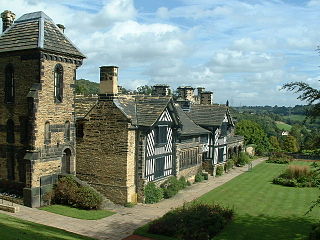
Shibden is a small dispersed community in Calderdale, West Yorkshire, England. Shibden Hall has a north-west driveway to its lake, café and miniature railway; an adjoining driveway runs up a landscaped garden to the hall which hosts the West Yorkshire Folk Museum. The land sits on a north–south rise between deep brooks, shared with more populous Southowram to the south.
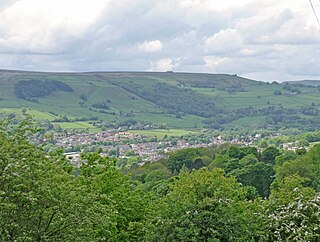
The Metropolitan Borough of Calderdale is a metropolitan borough of West Yorkshire, England. The estimated population in mid-2020 was 211,439. It takes its name from the River Calder, and dale, a word for valley. The name Calderdale usually refers to the borough through which the upper river flows, while the actual landform is known as the Calder Valley. Several small valleys contain tributaries of the River Calder.

Clifton is a small village, near Brighouse, in the metropolitan borough of Calderdale in West Yorkshire, England.

The Shay is a sports stadium in Halifax, West Yorkshire, England.
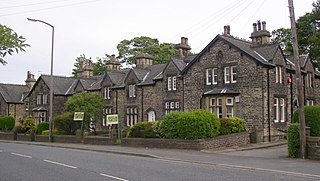
Lightcliffe is a village in the Calderdale district in West Yorkshire, England. Historically part of the West Riding of Yorkshire, it is situated approximately three miles east of Halifax and two miles north west of Brighouse. Lightcliffe was a separate parish in 1846 in the West Riding of Yorkshire.

Southowram is a village in Calderdale, West Yorkshire, England that stands on the hill top to the east of Halifax, on the south side of Shibden valley. The village falls within the Town ward of Calderdale Council. It is a small Pennine village near Bank Top, Brookfoot and Siddal. Northowram is on the northern side of the valley and is roughly equidistant from Halifax and Brighouse.

Northowram is a village in Calderdale, West Yorkshire, England that stands to the east of Halifax on the north side of Shibden valley. Southowram stands on the southern side of the valley.
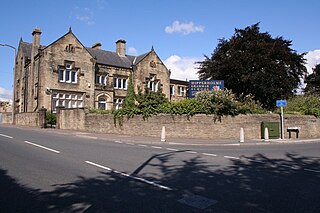
Hipperholme is a village in West Yorkshire, England, located between the towns of Halifax and Brighouse in the Hipperholme and Lightcliffe ward of the Metropolitan Borough of Calderdale. The population of this ward at the 2011 Census was 11,308.
The North Halifax Grammar School (NHGS) is a state grammar school, and former specialist Science college in Illingworth, Halifax, West Yorkshire, England.

Shelf is a village in Calderdale in West Yorkshire, England. The village is situated halfway, about 4 mi (6.4 km), between Bradford and Halifax, on the A6036 road. In 2001 it had a population of 4,496. At the 2011 Census Shelf was measured as part of the Calderdale ward of Northowram and Shelf.

Halifax is a minster and market town in the Metropolitan Borough of Calderdale in West Yorkshire, England. It is the commercial, cultural and administrative centre of the borough, and the headquarters of Calderdale Council. In the 15th century, the town became an economic hub of the old West Riding of Yorkshire, primarily in woollen manufacture. Halifax is the largest town in the wider Calderdale borough. Halifax was a thriving mill town during the industrial revolution.
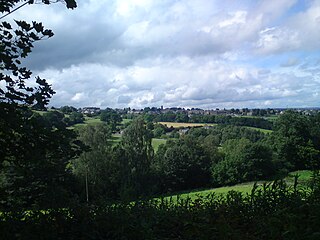
Stainland is a village and civil parish in Calderdale, West Yorkshire, England. The village is part of the Greetland and Stainland ward of Calderdale Council and is approximately 2 miles (3 km) west of Elland, 3.5 miles (6 km) south of Halifax and 4.3 miles (7 km) north-west of Huddersfield.
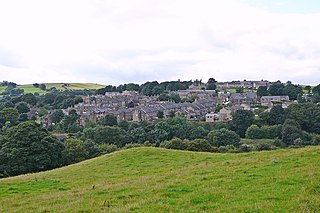
Holywell Green is a village in Calderdale, West Yorkshire, England. The village is situated approximately 1.4 miles (2 km) south-west of Elland, 3.3 miles (5 km) south of Halifax and 3.9 miles (6 km) north-west of Huddersfield. Holywell Green is part of the Greetland and Stainland Ward of Calderdale Council.
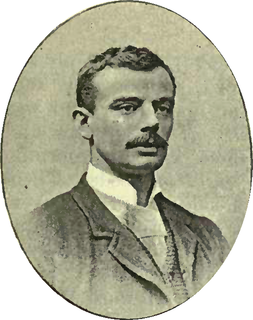
Fernand "Fred" Bonsor was a rugby union international who represented England from 1886 to 1889, he also captained his country. At club level he played for Bradford FC, and Skipton RFC.

William Swinden Barber FRIBA, also W. S. Barber or W. Swinden Barber, was an English Gothic Revival and Arts and Crafts architect, specialising in modest but finely furnished Anglican churches, often with crenellated bell-towers. He was based in Brighouse and Halifax in the West Riding of Yorkshire. At least 15 surviving examples of his work are Grade II listed buildings, including his 1875 design for the Victoria Cross at Akroydon, Halifax. An 1864 portrait by David Wilkie Wynfield depicts him in Romantic garb, holding a flower. He served in the Artists Rifles regiment in the 1860s alongside Wynfield and other contemporary artists.

Spring Hall, also known as Spring Hall Mansions, is a mansion situated off the Huddersfield Road, Halifax, West Yorkshire. A house had been built on the site by 1614, but it was demolished in 1870 leaving only the cellars. It was rebuilt in Gothic Revival style and completed in 1871 to a larger ground plan by architects James Mallinson and William Swinden Barber for Tom Holdsworth.

Holdsworth House is a Grade II* listed building at Holdsworth in Halifax, West Yorkshire, England. Built in 1633, it is a Jacobean mansion built in sandstone with narrow, leaded windows.